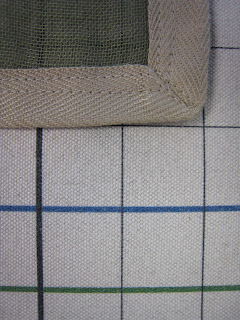We do a lot of hand-sewing around here, but sometimes it's all about patient machine work. For this small shade, we bound two layers of green sheer linen with 1 5/8" twill tape on 4 sides.
This ripply self-lined linen was a little hard to handle. First the twill tape was secured with a narrow strip of fusible interfacing tape. The fusible stuff penetrated both fabric layers, serving as basting. Then it was folded and pressed and top-stitched, with the corners mitered.
For this lacy unlined cotton, I wasn't sure I would do a good job matching the pattern using a French seam. So I sewed right sides together, and felled the seam.
Pressed to the side, the felled seam is very cool. This really beautiful fabric is about to become a softly gathered London shade valance.
More about French seams here.
Some may disagree with me, but for sheers, especially stretch panels, when the budget does not allow for hand-sewing, I prefer the blind hem of a regular household machine to that of a blindhemming machine. I think the blindhemmer makes a stitch that looks too commercial and also distorts the fabric if the tension is not just right. Say what you like, I happen to like the domestic machine blind hem. I love those little V-stitches all in a row. I love that it looks like a person made this using a machine, not a factory.
Patient topstitching creates precise headers and pockets to complete these sheer linen stretch panels. The fabric was cut by pulling threads to be sure it was cut perfectly on-grain, in both directions.
THE BLOG IS HAVING TROUBLE WITH COMMENTS! SOMETIMES THEY DON’T GET PUBLISHED, AND WHEN THEY ARE I AM UNABLE TO REPLY TO THEM. IF THAT HAPPENS, JUST EMAIL ME AT stitchlore@gmail.com.
Looking for something specific? Check out the Topic Index, or the Search bar, just below, on the left.
Sorry about this problem!
SO.........WHAT ARE WE WORKING ON TODAY??







No comments:
Post a Comment